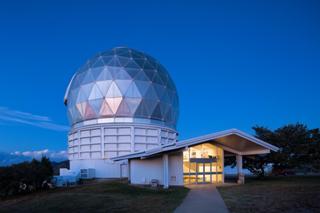Nov 4 2015
After several years and a massive team effort, one of the world’s largest telescopes, the Hobby-Eberly Telescope (HET) at The University of Texas at Austin’s McDonald Observatory, has opened its giant eye again, achieving “first light” as the world’s third-largest optical telescope.
 The dome of the Hobby-Eberly Telescope at McDonald Observatory. Ethan Tweedie Photography
The dome of the Hobby-Eberly Telescope at McDonald Observatory. Ethan Tweedie Photography
The revitalized HET, which uses more of its primary mirror, will contribute to many areas of science — not only the study of dark energy, but the nature of dark matter, the first stars in the universe, starburst galaxies, massive black holes, and will continue its already significant contribution to the confirmation and characterization of extrasolar planets.
“This upgrade makes HET the most powerful wide-field spectroscopic telescope worldwide, and we expect unique scientific discoveries from it,” observatory director Taft Armandroff said.
The new HET made its first image July 29. After extensive testing and fine-tuning, the team reports that image quality meets specifications— sharp enough to resolve features one mile across on the surface of the Moon (or in astronomical terms, a resolution of 0.9 arcseconds.)
Spurred by the HET collaboration’s desire to do big science projects, including the forthcoming Hobby-Eberly Telescope Dark Energy Experiment (HETDEX), the upgrade was a major undertaking that included new optics, mechanics and software. Today, HET is essentially a new telescope — only its primary mirror remains unchanged.
One of the major upgrades is the new Harold C. Simmons Dark Energy Optical System. This set of optics sits above the telescope’s main mirror, in the location usually occupied by a secondary mirror.
McDonald Observatory chief scientist Phillip MacQueen designed the system. He explained that the Simmons System, informally called a “corrector,” is a complex set of optics, including four mirrors, that achieves two key tasks.
First, it brings light from the primary mirror into sharp focus. Because HET’s primary mirror is spherical rather than parabolic, it does not focus light into a sharp image. To make sharp images, the primary mirror needs to feed light into a corrector before it is fed into scientific instruments.
Second, the Simmons System allows good images from all parts of the telescope’s greatly enlarged field of view. The telescope’s field of view has increased by 120 times, and is 70% of the diameter of the full Moon (that is, 22 arcminutes or one-third of a degree).
Research Associate Hanshin Lee managed a nearly seven-year process by The University of Arizona College of Optical Sciences to build and test the $6 million Simmons Optical System.
Once the Simmons System was built, the 2-ton assembly was transported from Tucson to McDonald Observatory in West Texas making the 500-mile trip overnight, going 45 miles per hour, with a police escort. Later testing verified that nothing had moved in the process — the optics were still aligned within a fraction of the width of a human hair.
Lee said that throughout the difficult building and testing process “our staff was really fantastic in stepping up — while solving problems, they showed a lot of creativity and conviction that they could do it,” noting that it took many people with different talents to make the project a success.
The Simmons System is “one of the most complex optical systems ever deployed in astronomy,” said Gary Hill, McDonald Observatory’s chief astronomer and principal investigator for HETDEX.
Because it allows more of HET’s 10-meter by 11-meter mirror to be used, it makes HET a larger telescope. The mirror’s effective size has increased from 9.2 meters to 10 meters. This means that HET is now tied for the world’s third-largest optical telescope.
The telescope also features a new tracker that supports the Simmons System as it moves across the primary mirror tracking cosmic targets across the sky. The new tracker was built by The University of Texas at Austin Center for Electromechanics. A McDonald Observatory team led by Niv Drory developed HET’s entirely new control system.
The Hobby-Eberly Telescope came online in 1997. It is a partnership between The University of Texas at Austin, The Pennsylvania State University, Georg-August-Universität Göttingen, and Ludwig-Maximilians-Universität München. The HET upgrade was funded by a combination of federal, state, and private sources.